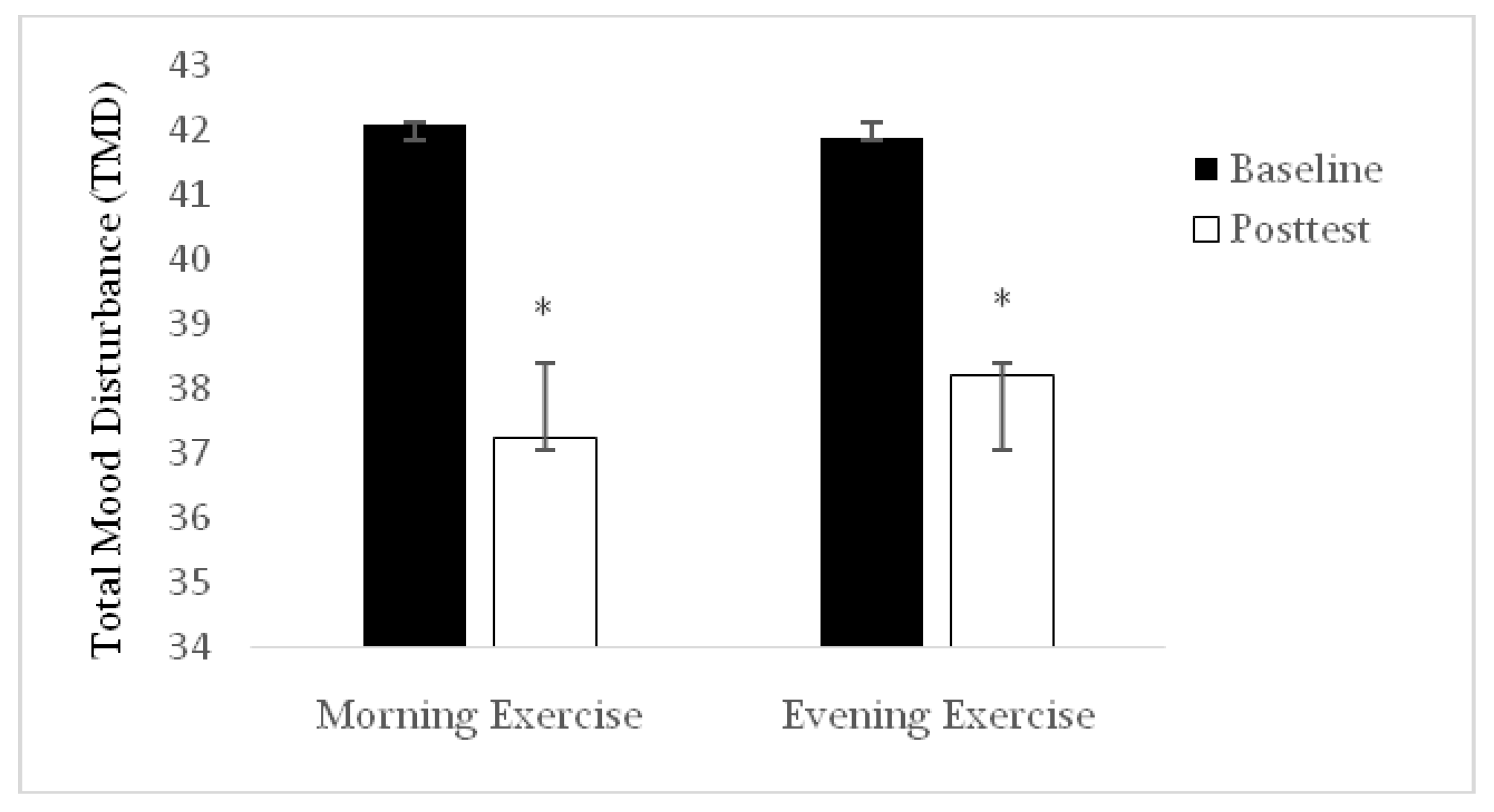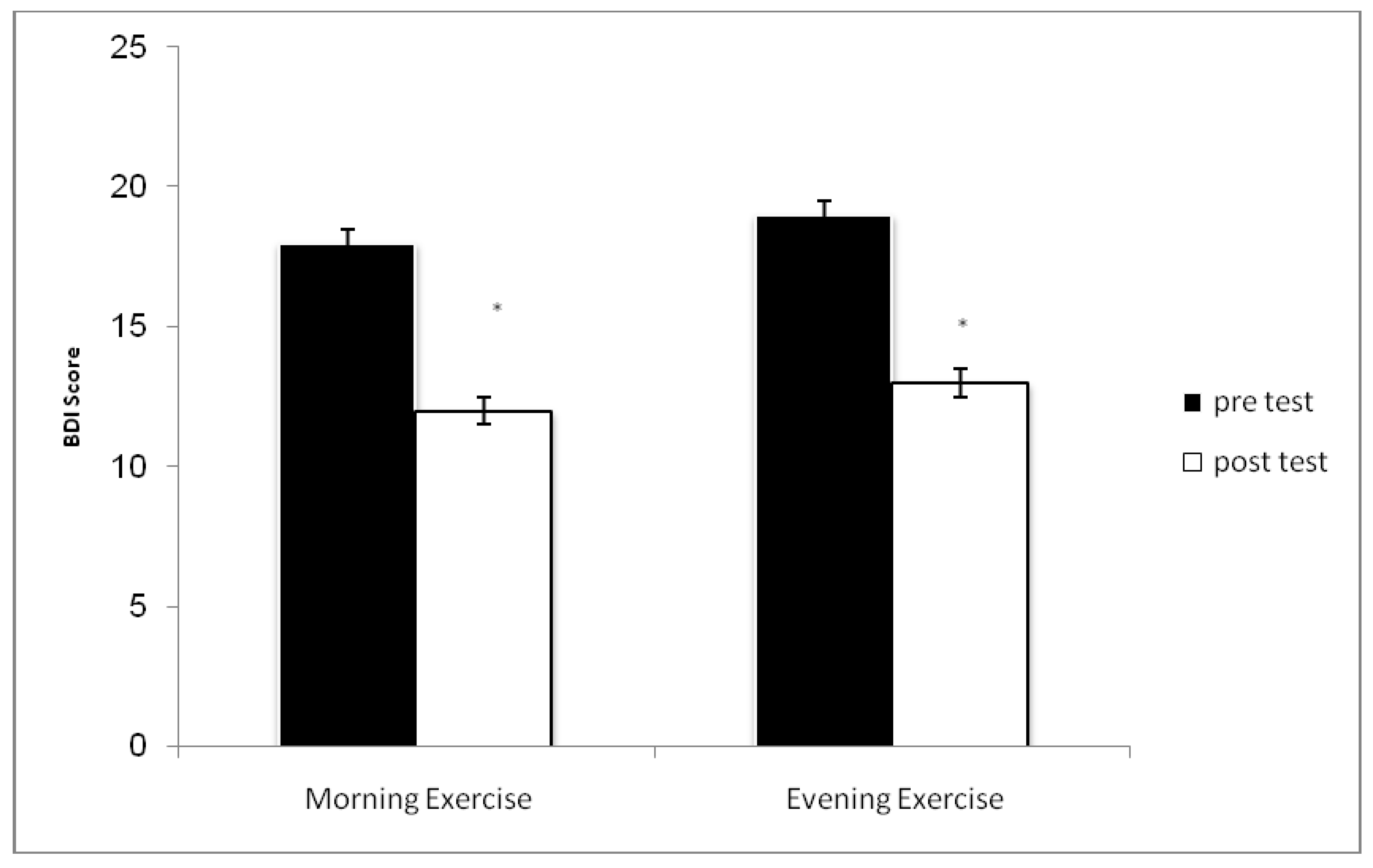Effect of Time-of-Day-Exercise in Group Settings on Level of Mood and Depression of Former Elite Male Athletes
Abstract
:1. Introduction
2. Materials and Methods
2.1. Ethical Approval
2.2. Subjects
2.3. Statistical Analysis
3. Results
4. Discussion
5. Conclusions
Author Contributions
Funding
Acknowledgments
Conflicts of Interest
References
- Murray, C.J.; Lopez, A.D.; World Health Organization. A comprehensive assessment of mortality and disability from diseases, injuries, and risk factors in 1990 and projected to 2020: Summary. In The Global Burden of Disease; Harvard School of Public Health: Cambridge, MA, USA, 1996. [Google Scholar]
- Abadi, H.A.Y.; Mirzaei, B.; Habibi, H.; Barbas, I. Prevalence of Rapid Weight Loss and Its Effects on Elite Cadet Wrestlers Participated in the Final Stage of National Championships. Int. J. Sport Stud. Health 2018, 1, e64316. [Google Scholar]
- Giannone, Z.A.; Haney, C.J.; Kealy, D.; Ogrodniczuk, J.S. Athletic identity and psychiatric symptoms following retirement from varsity sports. Int. J. Soc. Psychiatry 2017, 63, 598–601. [Google Scholar] [CrossRef] [PubMed]
- Filbay, S.R.; Bishop, F.L.; Peirce, N.; Jones, M.E.; Arden, N.K. Physical activity in former elite cricketers and strategies for promoting physical activity after retirement from cricket: A qualitative study. BMJ Open 2017, 7, e017785. [Google Scholar] [CrossRef] [PubMed]
- Eime, R.M.; Young, J.A.; Harvey, J.T.; Charity, M.J.; Payne, W.R. A systematic review of the psychological and social benefits of participation in sport for adults: Informing development of a conceptual model of health through sport. Int. J. Behav. Nutr. Phys. Act. 2013, 10, 1479–5868. [Google Scholar] [CrossRef] [PubMed]
- Eime, R.M.; Young, J.A.; Harvey, J.T.; Charity, M.J.; Payne, W.R. The Risk of Developing Obesity, Insulin Resistance, and Metabolic Syndrome in Former Power-sports Athletes—Does Sports Career Termination Increase the Risk. Indian J. Endocrinol. Metab. 2018, 22, 515–519. [Google Scholar]
- Albuquerque, F.N.; Kuniyoshi, F.H.S.; Calvin, A.D.; Sierra-Johnson, J.; Romero-Corral, A.; Lopez-Jimenez, F.; George, C.F.; Rapoport, D.M.; Vogel, R.A.; Khandheria, B.; et al. Sleep-disordered breathing, hypertension, and obesity in retired National Football League players. J. Am. Coll. Cardiol. 2010, 56, 1432–1433. [Google Scholar] [CrossRef]
- Kujala, U.M.; Sarna, S.; Kaprio, J.; Koskenvuo, M. Hospital care in later life among former world-class Finnish athletes. Jama 1996, 276, 216–220. [Google Scholar] [CrossRef] [PubMed]
- Berger, B.G.; Owen, D.R. Mood alteration with yoga and swimming: Aerobic exercise may not be necessary. Percept. Mot. Skills 1992, 75 (Suppl. 3), 1331–1343. [Google Scholar] [CrossRef]
- Teramoto, M.; Bungum, T.J. Mortality and longevity of elite athletes. J. Sci. Med. Sport 2010, 13, 410–416. [Google Scholar] [CrossRef]
- Fox, K.R. The influence of physical activity on mental well-being. Public Health Nutr. 1999, 2, 411–418. [Google Scholar] [CrossRef] [Green Version]
- Roberts, R.E.; Kaplan, G.A.; Shema, S.J.; Strawbridge, W.J. Are the obese at greater risk for depression? Am. J. Epidemiol. 2000, 152, 163–170. [Google Scholar] [CrossRef] [PubMed]
- Marcus, B.H.; Forsyth, L.H. Motivating People to be Physically Active; Human Kinetics: Leeds, UK, 2018. [Google Scholar]
- Randler, C. Association between morningness—Eveningness and mental and physical health in adolescents. Psychol. Health Med. 2011, 16, 29–38. [Google Scholar] [CrossRef] [PubMed]
- Kalak, N.; Gerber, M.; Kirov, R.; Mikoteit, T.; Yordanova, J.; Pühse, U.; Holsboer-Trachsler, E.; Brand, S. Daily morning running for 3 weeks improved sleep and psychological functioning in healthy adolescents compared with controls. J. Adolesc. Health 2012, 51, 615–622. [Google Scholar] [CrossRef] [PubMed]
- Trine, M.R.; Morgan, W.P. Influence of time of day on psychological responses to exercise. Sports Med. 1995, 20, 328–337. [Google Scholar] [CrossRef] [PubMed]
- Otto, M.; Smits, J.; Smits, J.A. Exercise for Mood and Anxiety: Proven Strategies for Overcoming Depression and Enhancing Well-Being; Oxford University Press: New York, NY, USA, 2011. [Google Scholar]
- Cooper, S.B.; Bandelow, S.; Nevill, M.E. Breakfast consumption and cognitive function in adolescent schoolchildren. Physiol. Behav. 2011, 103, 431–439. [Google Scholar] [CrossRef] [PubMed] [Green Version]
- Bartholomew, J.B.; Morrison, D.; Ciccolo, J.T. Effects of acute exercise on mood and well-being in patients with major depressive disorder. Med. Sci. Sports Exerc. 2005, 37, 2032–2037. [Google Scholar] [CrossRef] [PubMed]
- Leunes, A.; Burger, J. Profile of mood states research in sport and exercise psychology: Past, present, and future. J. Appl. Sport Psychol. 2000, 12, 5–15. [Google Scholar] [CrossRef]
- Sarkar, S.; Dey, S.K. Comparison of Anthropometric Characteristics, Body Composition Profile and Physical Fitness Parameters of Indian National Women Rugby Players According to Their Specific Playing Position. Int. J. Sport Stud. Health 2019, 2, e88855. [Google Scholar] [CrossRef]
- Irandoust, K.; Taheri, M. The effect of vitamin d supplement and indoor vs. outdoor physical activity on depression of obese depressed women. Asian J. Sports Med. 2017, 8, e13311. [Google Scholar] [CrossRef]
- Irandoust, K.; Taheri, M. The effects of aquatic exercise on body composition and nonspecific low back pain in elderly males. J. Phys. Ther. Sci. 2015, 27, 433–435. [Google Scholar] [CrossRef] [Green Version]
- Vogelzangs, N.; Kritchevsky, S.B.; Beekman, A.T.; Newman, A.B.; Satterfield, S.; Simonsick, E.M.; Yaffe, K.; Harris, T.B.; Penninx, B.W. Depressive symptoms and change in abdominal obesity in older persons. Arch. Gen. Psychiatry 2008, 65, 1386–1393. [Google Scholar] [CrossRef] [PubMed]
- Wegner, M.; Helmich, I.; Machado, S.; E Nardi, A.; Arias-Carrión, O.; Budde, H. Effects of exercise on anxiety and depression disorders: Review of meta-analyses and neurobiological mechanisms. CNS Neurol. Disord. Drug Targets (Former. Curr. Drug Targets CNS Neurol. Disord.) 2014, 13, 1002–1014. [Google Scholar] [CrossRef]
- Peluso, M.A.M.; Andrade, L.H.S.G.D. Physical activity and mental health: The association between exercise and mood. Clinics 2005, 60, 61–70. [Google Scholar] [CrossRef] [PubMed]
- Nabilpour, M.; Mayhew, J. Effect of Peripheral Heart Action on Body Composition and Blood Pressure in Women with High Blood Pressure. Int. J. Sport Stud. Health 2018, 1, e81874. [Google Scholar] [CrossRef]
- Amirsasan, R.; Nabilpour, M.; Pourraze, H.; Curby, D. Effect of 8-Week Resistance Training with Creatine Supplementation on Body Composition and Physical Fitness Indexes in Male Futsal Players. Int. J. Sport Stud. Health 2018, 1, e83810. [Google Scholar] [CrossRef]
- Naghavi, N.; Taheri, M.; Irandoust, K. Psychophysiological Responses to Cognitive and Physical Training in Obese Elderly. Int. J. Sport Stud. Health 2018, 1, e83935. [Google Scholar] [CrossRef]
- Jafari, M.; Pouryamehr, E.; Fathi, M. The Effect of Eight Weeks High Intensity Interval Training (HIIT) on E-Selection and P-Selection in Young Obese Females. Int. J. Sport Stud. Health 2018, 1, e64336. [Google Scholar] [CrossRef]
- Sayyah, M.; Rahimi, S.M.; Bigdeli, M.; Rajabi, M. Comparing the anthropometric characteristics of injured and non-injured girl student athletes participating in the sport olympiads held by the ministry of health and medical education in the summer of 2009 in the city of Yazd. Biosci. Biotechnol. Res. Asia 2011, 8, 367–371. [Google Scholar] [CrossRef]
- Chtourou, H.; Souissi, N. The effect of training at a specific time of day: A review. J. Strength Cond. Res. 2012, 26, 1984–2005. [Google Scholar] [CrossRef]
- Chtourou, H.; Hammouda, O.; Souissi, N.; Chaouachi, A. Temporal Specificity of Training: An Update. J. Strength Cond. Res. 2014, 4, 90–100. [Google Scholar]
- Chtourou, H.; Driss, T.; Souissi, S.; Gam, A.; Chaouachi, A.; Souissi, N. The effect of strength training at the same time of the day on the diurnal fluctuations of muscular anaerobic performances. J. Strength Cond. Res. 2012, 26, 217–225. [Google Scholar] [CrossRef] [PubMed]
- Souissi, H.; Chtourou, H.; Chaouachi, A.; Dogui, M.; Chamari, K.; Souissi, N.; Amri, M. The effect of training at a specific time-of-day on the diurnal variations of short-term exercise performances in 10-to 11-year-old boys. Pediatr. Exerc. Sci. 2012, 24, 84–99. [Google Scholar] [CrossRef] [PubMed]
- Chtourou, H.; Chaouachi, A.; Driss, T.; Dogui, M.; Behm, D.G.; Chamari, K.; Souissi, N. The effect of training at the same time of day and tapering period on the diurnal variation of short exercise performances. J. Strength Cond. Res. 2012, 26, 697–708. [Google Scholar] [CrossRef] [PubMed]


| Age (year) | 46.2 ± 2.1 | |
| Weight | 85.3 ± 3.7 | |
| WHR | 0.94 ± 0.01 | |
| Variables | Classification | Percentage |
| Income | Low (≤2,000,000 T) | 9% |
| Medium (2,000,0000–4,000,000 T) | 67% | |
| High (≥4,000,000 T) | 24% | |
| Level of education | Diploma | 11% |
| Associate | 4% | |
| Bachelor | 35% | |
| Master | 26% | |
| Occupation | Employed | 78% |
| Self-employed | 22% | |
| Marital status | Single | 4% |
| Married | 81% | |
| Widowed | 8% | |
| Divorced | 7% | |
| Mood States Parameters | ME (n = 34) | t | p | EE (n = 33) | t | p | ||
|---|---|---|---|---|---|---|---|---|
| Baseline | Post-Test | Baseline | Post-Test | |||||
| Anger | 8.21 ± 1.5 | 6.25 ± 1.6 | 7.14 | 0.001 | 8.51 ± 1.5 | 6.11 ± 1.9 | 7.25 | 0.001 |
| Confusion | 9.72 ± 1.7 | 8.85 ± 1.8 | 2.81 | 0.008 | 10.21 ± 1.5 | 8.35 ± 1.6 | 6.8 | 0.001 |
| Depression | 13.52 ± 2.1 | 11.3 ± 2.4 | 5.58 | 0.001 | 12.9 ± 1.8 | 10.9 ± 1.5 | 7.65 | 0.001 |
| Fatigue | 16.27 ± 3.2 | 14 ± 2.6 | 4.48 | 0.001 | 15.1 ± 2.2 | 13.6 ± 1.9 | 4.53 | 0.001 |
| Tension | 10.31 ± 1.9 | 8.1 ± 1.2 | 10.69 | 0.001 | 9.3 ± 2.1 | 8 ± 1.5 ± 2.2 | 3.13 | 0.003 |
| Vigor | 6.45 ± 1.4 | 4.8 ± 1.0 | 9.33 | 0.001 | 6.2 ± 1.3 | 5.1 ± 1.1 | 5.75 | 0.001 |
© 2019 by the authors. Licensee MDPI, Basel, Switzerland. This article is an open access article distributed under the terms and conditions of the Creative Commons Attribution (CC BY) license (http://creativecommons.org/licenses/by/4.0/).
Share and Cite
Irandoust, K.; Taheri, M.; Chtourou, H.; Nikolaidis, P.T.; Rosemann, T.; Knechtle, B. Effect of Time-of-Day-Exercise in Group Settings on Level of Mood and Depression of Former Elite Male Athletes. Int. J. Environ. Res. Public Health 2019, 16, 3541. https://0-doi-org.brum.beds.ac.uk/10.3390/ijerph16193541
Irandoust K, Taheri M, Chtourou H, Nikolaidis PT, Rosemann T, Knechtle B. Effect of Time-of-Day-Exercise in Group Settings on Level of Mood and Depression of Former Elite Male Athletes. International Journal of Environmental Research and Public Health. 2019; 16(19):3541. https://0-doi-org.brum.beds.ac.uk/10.3390/ijerph16193541
Chicago/Turabian StyleIrandoust, Khadijah, Morteza Taheri, Hamdi Chtourou, Pantelis Theo Nikolaidis, Thomas Rosemann, and Beat Knechtle. 2019. "Effect of Time-of-Day-Exercise in Group Settings on Level of Mood and Depression of Former Elite Male Athletes" International Journal of Environmental Research and Public Health 16, no. 19: 3541. https://0-doi-org.brum.beds.ac.uk/10.3390/ijerph16193541








